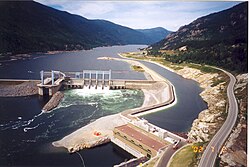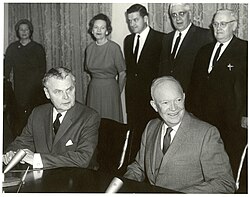Treaty provisions
Dams in the Upper Columbia River and Tributaries | ||||||||||||||||||||||||||||||||||||||||||||||||||||||||||||||||||||||||||||||||||||||||||||||||||||||||||||||||||||||||||||||||||||||||||||||||||||||||||||||||||||||||||||||||||||||
|---|---|---|---|---|---|---|---|---|---|---|---|---|---|---|---|---|---|---|---|---|---|---|---|---|---|---|---|---|---|---|---|---|---|---|---|---|---|---|---|---|---|---|---|---|---|---|---|---|---|---|---|---|---|---|---|---|---|---|---|---|---|---|---|---|---|---|---|---|---|---|---|---|---|---|---|---|---|---|---|---|---|---|---|---|---|---|---|---|---|---|---|---|---|---|---|---|---|---|---|---|---|---|---|---|---|---|---|---|---|---|---|---|---|---|---|---|---|---|---|---|---|---|---|---|---|---|---|---|---|---|---|---|---|---|---|---|---|---|---|---|---|---|---|---|---|---|---|---|---|---|---|---|---|---|---|---|---|---|---|---|---|---|---|---|---|---|---|---|---|---|---|---|---|---|---|---|---|---|---|---|---|---|
| Left: Columbia River, Right: Duncan River and connections, Lower right: Pend Oreille River | ||||||||||||||||||||||||||||||||||||||||||||||||||||||||||||||||||||||||||||||||||||||||||||||||||||||||||||||||||||||||||||||||||||||||||||||||||||||||||||||||||||||||||||||||||||||
| ||||||||||||||||||||||||||||||||||||||||||||||||||||||||||||||||||||||||||||||||||||||||||||||||||||||||||||||||||||||||||||||||||||||||||||||||||||||||||||||||||||||||||||||||||||||
| Canadian waterways in red United States waterways in blue Columbia River Treaty dams in bold Canal Plant Agreement dams in italic Dams are in British Columbia unless otherwise noted. | ||||||||||||||||||||||||||||||||||||||||||||||||||||||||||||||||||||||||||||||||||||||||||||||||||||||||||||||||||||||||||||||||||||||||||||||||||||||||||||||||||||||||||||||||||||||
| Duncan Dam | |
|---|---|
 | |
 Interactive map of Duncan Dam | |
| Country | Canada |
| Location | Howser, British Columbia |
| Coordinates | 50°15′03″N116°57′03″W / 50.25083°N 116.95083°W |
| Dam and spillways | |
| Impounds | Duncan River |
| Reservoir | |
| Creates | Duncan Lake |
| Total capacity | 1.70 km3 (1.38 million acre⋅ft) |
| Hugh Keenleyside Dam | |
|---|---|
 | |
 Interactive map of Hugh Keenleyside Dam | |
| Country | Canada |
| Location | Castlegar, British Columbia |
| Coordinates | 49°20′22″N117°46′19″W / 49.33944°N 117.77194°W |
| Dam and spillways | |
| Impounds | Columbia River |
| Reservoir | |
| Creates | Arrow Lakes |
| Total capacity | 8.76 km3 (7.10 million acre⋅ft) |
| Mica Dam | |
|---|---|
 | |
 Interactive map of Mica Dam | |
| Country | Canada |
| Location | Mica Creek, British Columbia |
| Coordinates | 52°04′40″N118°33′59″W / 52.07778°N 118.56639°W |
| Dam and spillways | |
| Impounds | Columbia River |
| Reservoir | |
| Creates | Kinbasket Lake |
| Total capacity | 15 km3 (12 million acre⋅ft) |
| Libby Dam | |
|---|---|
 | |
 Interactive map of Libby Dam | |
| Country | United States |
| Location | Libby, Montana |
| Coordinates | 48°24′37″N115°18′54″W / 48.41028°N 115.31500°W |
| Dam and spillways | |
| Impounds | Kootenai River |
| Reservoir | |
| Creates | Lake Koocanusa |
| Total capacity | 7.43 km3 (6.02 million acre⋅ft) |
Under the terms of the agreement, Canada was required to provide 19.12 km3 (15.5 million acre-feet [Maf]) of usable reservoir storage behind three large dams. This was to be accomplished with 1.73 km3 (1.4 Maf) provided by Duncan Dam (1967), 8.76 km3 (7.1 Maf) provided by Arrow Dam (1968) (subsequently renamed the Hugh Keenleyside Dam), and 8.63 km3 (7.0 Maf) provided by Mica Dam (1973). The latter dam, however, was built higher than required by the treaty, and thus provides a total of 14.80 km3 (12 Maf) including 6.17 km3 (5.0 Maf) of Non Treaty Storage space. Unless otherwise agreed, the three Canadian Treaty projects are required to operate for flood protection and increased power generation at-site and downstream in both Canada and the United States, although the allocation of water storage operations among the three projects is at Canadian discretion. The downstream power and flood control benefits in the United States created by the operation of Canada's Treaty reservoirs are shared by the two countries in accordance with Treaty provisions.
The treaty also allowed the U.S. to build the Libby Dam on the Kootenai River in Montana which provides a further 6.14 km3 (4.98 Maf) of active storage in the Koocanusa reservoir. Although the name sounds like it might be of aboriginal origins, it is actually a concatenation of the first three letters from Kootenai / Kootenay, Canada and USA, and was the winning entry in a contest to name the reservoir. Water behind the Libby dam floods back 42 mi (68 km) into Canada, while the water released from the dam returns to Canada just upstream of Kootenay Lake. Libby Dam began operation in March 1972 and is operated for power, flood control and other benefits at-site and downstream in both Canada and the United States. The U.S. did not pay Canada for the land submerged by the Libby Dam reservoir and Canada does not pay the U.S. for the resulting power and flood control benefits downstream on the Kootenay River.
With the exception of the Mica Dam, which was designed and constructed with a powerhouse, the Canadian Treaty projects were initially built for the sole purpose of regulating water flow. In 2002, however, a joint venture between the Columbia Power Corporation and the Columbia Basin Trust constructed the 185 MW Arrow Lakes Hydro project in parallel with the Keenleyside Dam near Castlegar, 35 years after the storage dam was originally completed. The Duncan Dam remains a storage project, and has no power generation facilities.
The Canadian and U.S. Entities defined by the treaty, and appointed by the national governments, manage most of the treaty required activities. The Canadian Entity is BC Hydro and Power Authority, and the U.S. Entity is the Administrator of the Bonneville Power Administration and the Northwestern Division Engineer for the U.S. Army Corps of Engineers. The treaty also established a Permanent Engineering Board, consisting of equal members from Canada and the U.S., that reports to both governments annually on Treaty issues, any deviations from the operating plans, and assists the Entities in resolving any disputes.
Payment for U.S. Benefits
As payment for the U.S. benefits realized by the Canadian storage operation, the treaty required the U.S. to:
- deliver to Canada half of the estimated increase in U.S. downstream power benefits, on an ongoing basis (the Canadian Entitlement), and
- make a one-time monetary payment as each of the dams were completed for half of the value of the estimated future flood damages prevented in the U.S.
The Canadian Entitlement is calculated five years in advance for each operating year using an agreed treaty calculation method, and the amount varies mainly as a function of forecasted power loads, thermal generating resources and operating procedures. The method gives Canada a "first-added" storage benefit that ignores U.S. dams built after 1961 (e.g. Libby and Dworshak), limits sales of surplus power to California, and excludes modern fish related constraints at U.S. dams. Without the first two of these limits, the Canadian Entitlement would be slightly less than half of current values. The Canadian Entitlement is marketed by Powerex. [18] The Canadian Entitlement varies from year to year, but is generally in the range of 4,400 GWh per year and about 1,250 MW of capacity. [19]
The treaty required the U.S. to pay a total of $64.4 million (C$69.6 million) for the flood control benefits due to the operation of 8.45 Maf of Canadian storage. The payment was based on an allocation that:
- gives Canada equal credit to U.S. projects existing in 1961 (better than first added),
- ignores the flood control benefits provided by Libby and other post-1961 U.S. projects, and
- also ignores the flood control benefits provided by the Canadian power storage operation that normally drafts far more than the 8.45 Maf flood control obligation. The estimated annual benefit was capitalized for an up-front payment based on a low U.S. interest rate of 3+7⁄8 percent for the flood damages prevented until September 2024. The U.S. insisted on determining the payment based on benefits until 2024 because the alternative was to construct U.S. dams that would be fully paid for by then. Canada accepted the calculation method and explained to Parliament that the $64.4 million is 24% greater than the value to Canada at 5+1⁄2% interest of annual payments made in perpetuity. Absent any new agreements, the U.S. purchase of an annual operation of Canadian storage for flood control will expire in 2024 and be replaced with an option for the U.S. to "Call Upon" Canadian storage for flood control needs that cannot adequately be met by U.S. projects, and the U.S. must pay Canada for operating costs and any economic losses due to requested flood control operations.
Termination
The treaty has no end date, but it includes an option for either country to terminate most treaty provisions anytime after 60 years (i.e. 16 September 2024), given at least 10 years advance notice. If the treaty is terminated, several provisions continue including Called Upon flood control, operation and coordination of Libby, and Kootenay River diversion rights. [20]
The Canadian and U.S. governments reviewed the treaty before the 2014 opportunity for notice for earliest termination. Options generally fell into three categories:
- Continue the treaty with the automatic change to called upon flood control,
- Terminate the treaty (with continued called upon flood control), or
- Negotiate changes to the treaty that modify the flood control and power obligations and/or create new provisions for other benefits, especially environmental objectives.
The BC [21] and US [22] governments launched websites to inform and engage citizens about the review.
As of March 9, 2025, the Trump Administration has said they "want changes" made to the Columbia River Treaty. [23]

